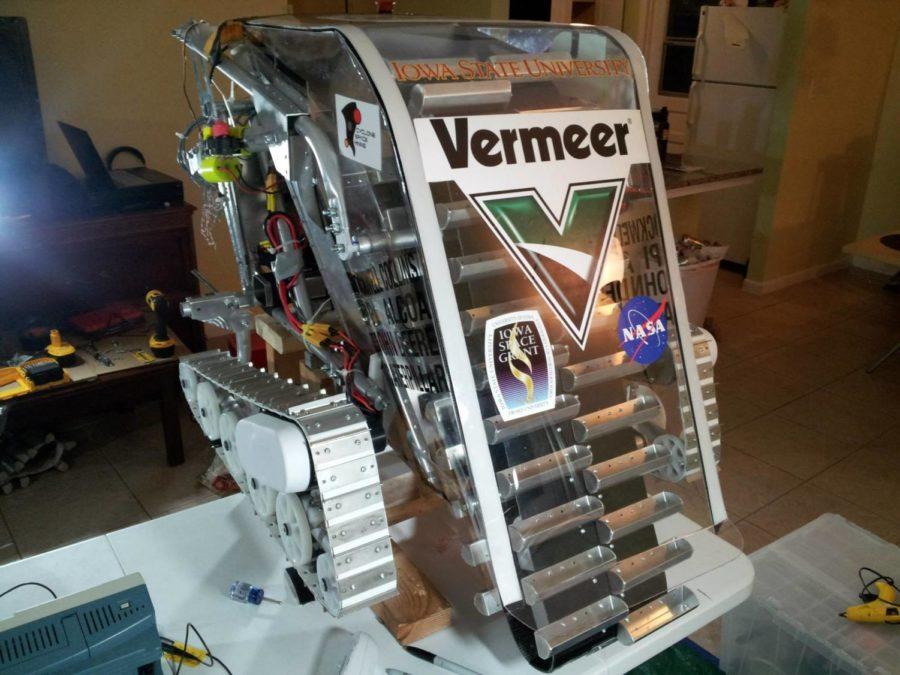ISU Lunabotics Club vows to improve after competition
Courtesy of ISU Lunabotics Club
The ISU Lunabotics Club built HERMES 2.5 this year to compete at the annual NASA Lunabotics Mining Competition at the Kennedy Space Center.
June 3, 2015
The learning experience the ISU Lunabotics Club encountered at this year’s NASA Lunabotics Mining Competition won’t go to waste.
The ISU Lunabotics Club discovered that one of the motors in its linear actuators burned out because of programming errors hours before the club’s first 10-minute run at the Kennedy Space Center in Titusville, Fla.
The ISU Lunabotics club has competed in the NASA Lunabotics Mining Competition since it started six years ago and has often been one of the top teams. The goal of the competition is to collect as much regolith, or moon dirt, as possible in 10 minutes with a student-designed rover. The competition uses a substance with the same physical makeup as regolith.
The ISU Lunabotics Club placed first in the mining competition in 2012 and attended a second competition in Hawaii last year, as well as broke the single run points record.
About 10 to 12 people worked on this year’s rover, HERMES 2.5. But the team did not construct or test the rover until the month before the competition. This led to malfunctions during the first run.
After the motor burned out, the team used its one spare motor, but did not have time to test it before the competition began.
Tyler Broich, vice president of the ISU Lunabotics Club, said repairing an actuator can be moderately difficult because of all the wiring in the rover. The club discovered that the spare motor was also a dud when the first run began, and the rover was unable to lift the conveyor off the ground.
Because the motors the club used in its rover are sourced in England, the club was unable to retrieve a new one before the second run.
As a last resort, members of the club went to a hardware store and found drills on sale that had similar motors. The team tore apart the drills and found the motors were the correct size and would work for the rover, but they were slower and weaker than the original ones.
Computer programming troubles resulted in failure during the second run for the ISU Lunabotics Club. Jim Heise, the ISU Lunabotics Club adviser, said he believes the club’s design was solid and had the potential of winning if the controls had worked.
The team was unable to qualify for either run, but did not leave empty handed. It finished third in the outreach category and was given the award for the best use of social media out of the 47 teams that participated.
The difficulties encountered this year have encouraged the team to excel in the future.
Team members said they plan to make minor changes to the rover, train the team to know how to run the rover and add a localization system for next year’s competition. They also plan to make it to the second competition in Hawaii next year.
“Cyclone space mining will be continuing its endeavors to go boldly where no other team has gone before,” Heise said.
Broich said the competitions are places where friendships are formed and ideas are swapped, and one of the best parts is talking to the judges, who are all NASA employees. Having the opportunity to see other designs helps the club gain inspiration for future rovers.
The club will focus more on outreach leading up to next year’s competition. Heise said the club should have four STEM outreach programs by the end of this summer, and the first will start next week. The club will also have two events at the Science Center of Iowa, as well as online chats.
In addition to all the events, the club helps rookie teams, posts blogs to share the technology it creates and gives ideas to other teams. The club is in contact with 13,000 to 15,000 people every year.
Heise said the mining rovers are the first step toward In Situ Resource Utilization, the act of mining resources from extra terrestrial bodies for the benefit of our planet. He said big things will happen in science during the next century.
“Space technology right now is at the same point that aviation technology, which we take for granted, was when Charles Lindbergh flew [over] the ocean,” Heise said. “It’s kind of where we’re at. And I think over the course of the next century, you’re going to see some incredible things happen.”
Despite the technical problems experienced at this year’s competition, the team is determined to get its rover in top shape for next year. The team also plans to break its own single run points record.
“People can expect that Iowa State will be back in a big way next year,” Heise said.

















